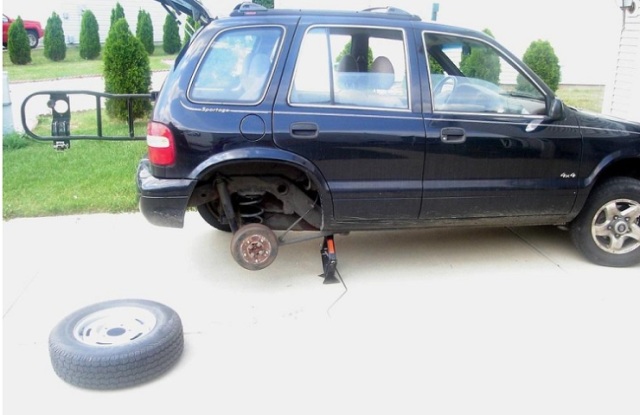Rotating tires of a car on a regular basis keeps your tire from getting worn out easily. Check out how to rotate tires.
Rotating Tires
A car can run longer distances and give a better performance for a number of years only if you maintain it properly. The servicing of the engine is not enough. The car does not run solely on the engine. An integral part of the car which many people easily ignore is the tire. Due to daily use, they get worn and torn and ultimately, they are so burnt out that you need to buy new ones, eventually making a dent in your pocket. An easy solution to this is rotating tires. Doing so on a regular basis will extend the life of the tires and improve their performance. As the name suggests, you need to exchange tires of the front and back. The process doesn’t take much of your time and is completely inexpensive. In case you are still clueless about this, check out this information on how to rotate tires. 

Image: chris.corwin@flickr
How To Rotate Tires
Things You’ll Need:
- 4 Jack Stands
- Car Jacks
- Flat Head Screwdriver
- Torque Wrenches
- Air Impact Gun
- Spare Tires
- Tires
Instructions
- Keep spare tires ready with you for changing. It should be the regular tire you can use for long distance driving and not the temporary spare that is used in case of an emergency.
- Make sure that your car is parked on a flat, level surface with plenty of clear space available all around.
- Just before you raise your car in the air, remove the hubcaps, in case the wheels have, using a flat head screwdriver to bring forward the lug nuts.
- Take the 4 jack stands and jack up the car carefully. The car must be raised on a plain level and each jack must be raised uniformly so as to provide balance and symmetry.
- Affix the proper socket in an air impact gun and remove the lug nuts from each tire. Once removed, keep the lug nuts close to the tire to make it easy while replacing the tire.
- Now, while holding onto the tire, remove it from the stud jiggling it firmly, using both your hands. To make the task easier, seat yourself comfortably on the ground. Place the tire on the ground.
- After you’ve removed all the tires from their studs, move them to their new location.
- The positioning of the tires to their new location will entirely depend upon the type of tires your vehicle has – directional or non-directional. In case of directional tires, the front-right tire should be switched with the back-right tire. The same pattern follows for the left side tires. Whereas for non-directional tires, use the cross pattern, wherein you move the left-front tire to the right-rear and the right-front tire to the left-rear, while bringing the rear tires straight forward.
- Place the tires on the studs and replace the lug nuts onto the stud. First, finger-tighten them and further tighten them into their place by using the air impact gun in a star pattern.
- Once you’ve tightened and affixed all the tires to their new positions, gradually lower the car back to the ground and remove the car jacks.
- Complete tightening the lug nuts with the help of a torque wrench, according to the specifications.
- Place the hubcaps on the wheels and press them back into position using your hands.
- Finally, check the air pressure and your tire rotation is complete.
Note down the mileage after you’ve completed the tire rotation process. Do not forget to rotate the tires again after driving your vehicle for another 5,000 miles. By rotating the tires regularly, the natural wear and tear pattern can be equalized, thus giving you a smoother and safer ride.
See also
- BMW | Bajaj Auto Ltd | Bentley | Car Insurance | Cars in India | Concept Cars | Fiat | Ford | General Motors | Geneva Auto Show
More from iloveindia.com
- Home Remedies | Ayurveda | Vastu | Yoga | Feng Shui | Tattoos | Fitness | Garden | Nutrition | Parenting | Bikes | Cars | Baby Care | Indian Weddings | Festivals | Party ideas | Horoscope 2015 | Pets | Finance | Figures of Speech | Hotels in India : Delhi | Hyderabad | Chennai | Mumbai | Kolkata | Bangalore | Ahmedabad | Jaipur
- Contact Us Careers Disclaimer Privacy Policy Advertise With Us Lifestyle Sitemap Copyright iloveindia.com. All Rights Reserved.



